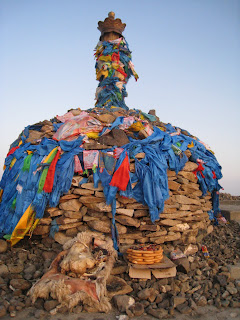1. Buy some meat. Between the 5 people on my trip we bought 22,000MNT (18USD) worth of meat.
I was satisfied that two giant hunks of meat would no doubt prove to be a feast for the nights dinner.
Our guide Mada said that we were buying beef, but like most of the beef I've eaten here it tasted suspiciously like mutton.
2. As you leave the butcher shop, take note of the authentic decor.
This butcher shop a freshly beheaded sheep's head next to a leathery sack that looked like skin, and a bottle of blood.
This is the stove.
3. Put some firewood in the stove along with the cooking rocks. The idea is to heat up the rocks until they are incredibly hot-- hot enough to cook the meat on.
4. When the rocks are hot enough, put them in a separate metal basin with the meat and other things you would like to eat. For us we had the hunks of meat cooking with potato and carrot.
5. Remove the rocks. The guy who was cooking our meat told me to put out my hands, and then he put one of the rocks into them. Those things are HOT!
I played hot potato with myself, tossing the rock from hand to hand until I had had enough, and gave it back to him.
Before calling us to dinner, the guy who cooked our food made off with half of our meat as well as the delicious soupy broth that you generally find at the bottom of the pan. Is this custom or thievery?
6. Eating!
To make up for our stolen meat, Mada brought us extra coleslaw...
:/
Good thing we bought vodka!
The aftermath:




























